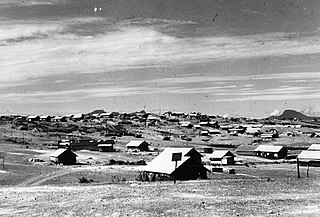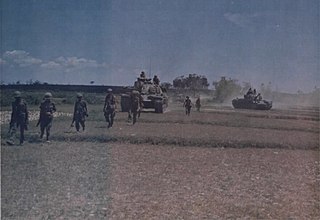
The 5th Marine Division was a United States Marine Corps ground combat division which was activated on 11 November 1943 at Camp Pendleton, California during World War II. The 5th Division saw its first combat action during the Battle of Iwo Jima in 1945 where it sustained the highest number of casualties of the three Marine divisions of the V Amphibious Corps. The 5th Division was to be part of the planned invasion of the Japan homeland before Japan surrendered. Assault troops of the 5th Division were included in the Presidential Unit Citation awarded to the V Amphibious Corps for extraordinary heroism on Iwo Jima from 19 to 28 February 1945. The 5th Division was deactivated on 5 February 1946.

The 27th Marine Regiment is an inactivated infantry regiment of the United States Marine Corps. They fought during the battle of Iwo Jima in World War II and again for a short time during the Vietnam War.

The 26th Marine Regiment is an inactivated infantry regiment of the United States Marine Corps. The 26th Marines were activated in 1944 and fought in the Battle of Iwo Jima during World War II and were activated again on 1 March 1966, and fought in the Battle of Khe Sanh during the Vietnam War.

Khe Sanh Combat Base was a United States Marine Corps outpost south of the Vietnamese Demilitarized Zone (DMZ) used during the Vietnam War.

Hill 55 is a hill 16 kilometres (9.9 mi) southwest of Da Nang, Quảng Nam Province, Vietnam. The hill is located 3 kilometres (1.9 mi) northeast of the confluence of the Yen, Ai Nghia, and La Tho Rivers and was a United States Marine Corps base during the Vietnam War.

Operation Taylor Common was a search and destroy operation conducted by Task Force Yankee, a task force of the 1st Marine Division supported by the Army of the Republic of Vietnam (ARVN), southwest of Hội An from 6 December 1968 to 8 March 1969.

Ca Lu Combat Base was an Army of the Republic of Vietnam (ARVN) and United States Marine Corps base located on Highway or Route 9, near Krông Klang, Đa Krông District, western Quảng Trị Province, South Vietnam.
The 304 Division is an infantry division of the People's Army of Vietnam (PAVN). It was established in January 1950 at Thanh Hoa.

Operation Robin was a U.S. Marine Corps operation that took place southeast of Khe Sanh, Quảng Trị Province from 2–19 June 1968.

Hill 950 was a U.S. Marine Corps and MACV-SOG base located north of Khe Sanh, in Quảng Trị Province.

Operation Lancaster was a U.S. Marine Corps operation that took place in northern Quảng Trị Province from November 1967 to January 20, 1968.
The 1st Battalion, 26th Marines (1/26) is an inactive infantry battalion of the United States Marine Corps. They were part of the 26th Marine Regiment and 5th Marine Division and fought during the Battle of Iwo Jima in World War II. They were activated again for the Vietnam War but were deactivated after the war and remain inactive today.
The 2nd Battalion, 26th Marines (2/26) is an inactive infantry battalion of the United States Marine Corps. They were part of the 26th Marine Regiment and 5th Marine Division and fought during the Battle of Iwo Jima in World War II. They were activated again for the Vietnam War but were deactivated after the war and remain inactive today.
Operation Neosho was a security operation in northern Thừa Thiên Province, South Vietnam from 1 November 1967 to 25 January 1968.
Operation Scotland II was a U.S. Marine Corps security operation that took place in northwest Quảng Trị Province from 15 April 1968 to 28 February 1969.
Operation Utah Mesa was a United States Marine Corps, United States Army and Army of the Republic of Vietnam (ARVN) operation in northwest Quảng Trị Province, South Vietnam from 12 June to 6 July 1969.

David Edward Lownds was a United States Marine Corps colonel who served in the Vietnam War, notably as ground commander at Khe Sanh Combat Base during the Battle of Khe Sanh in 1968.
Operation Houston was a security operation in the Vietnam War conducted by the United States Marine Corps’ Task Force X-Ray to reopen and secure Route 1 between Da Nang and Phu Bai Combat Base that took place from 26 February to 12 September 1968.

Operation Crockett was an operation during the Vietnam War conducted by the United States Marine Corps against People's Army of Vietnam (PAVN) forces around Khe Sanh Combat Base in northwest Quảng Trị Province that took place from 13 May to 16 July 1967. The PAVN tested U.S. defenses, forcing the Marines to deploy additional forces to the area, following which the PAVN disengaged but did not withdraw from the area. The operation resulted in 111 PAVN killed and one captured for Marine losses of 34 killed. The operation was immediately followed by Operation Ardmore, an ongoing security operation.

Operation Concordia Square was an operation conducted by the United States Army 2nd Brigade, 1st Cavalry Division south of the Vietnamese Demilitarized Zone in Quảng Trị Province. The operation ran from 8 to 17 May 1968.













